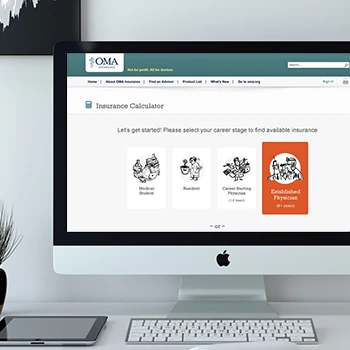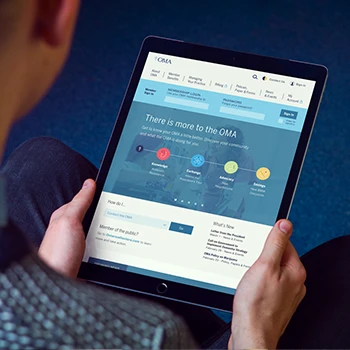What makes member association UX research different from other sectors?
Member associations have a unique challenge: they must balance diverse member needs while maintaining organizational relevance. Unlike commercial customers, members have ongoing relationships with varying engagement levels, professional requirements, and expectations for value delivery. Our research approach uses the Experience Thinking framework to understand how members experience your brand, content, products, and services as connected touchpoints rather than isolated interactions.
Tip: Look for researchers who understand the member lifecycle beyond simple transactional relationships.
How do you identify the different member personas within our association?
We conduct interviews and surveys across your membership base to uncover distinct behavioral patterns, professional needs, and engagement preferences. Our persona development process examines member roles, experience levels, usage frequency, and domain expertise to create actionable profiles that drive design decisions.
Tip: Ensure your research partner creates personas based on actual member behavior, not just demographics or assumptions.
What research methods work best for understanding member needs?
We use a mix of qualitative and quantitative approaches including member journey mapping, contextual interviews, usability testing, and ecosystem analysis. The Experience Thinking approach ensures we understand not just what members do, but why they do it and how their experiences connect across different touchpoints with your organization.
Tip: Choose methods that uncover both explicit needs and implicit behaviors that members may not articulate directly.
How do you account for members at different career stages?
Our research methodology acknowledges that member needs evolve throughout their professional journey. We examine how students, early-career professionals, established practitioners, and senior leaders interact differently with your association. This lifecycle approach helps design experiences that remain relevant as members progress.
Tip: Request research that maps member needs across career progression, not just current state analysis.
What's the best way to understand member engagement patterns?
We analyze both quantitative engagement data and qualitative member feedback to understand participation patterns, preferred communication channels, and content consumption habits. Our ecosystem mapping reveals how members interact with your association alongside other professional development resources.
Tip: Look for research that examines member behavior in context of their broader professional ecosystem, not just your association's touchpoints.
How do you research member expectations for professional development?
Through targeted interviews and journey mapping, we explore how members seek knowledge, skills development, and career advancement. Our research reveals the role your association plays in members' professional growth and identifies opportunities to strengthen that relationship through better experiences.
Tip: Ensure research explores both formal and informal learning preferences to design appropriate content and service experiences.
What research approach works for associations with declining membership?
We conduct research with current members, recent departures, and potential members to understand value perception gaps. Using Experience Thinking principles, we examine how your brand experience, content relevance, product usefulness, and service quality contribute to member retention decisions.
Tip: Include lapsed members in your research to understand barriers to continued engagement and identify improvement opportunities.
How do you develop an experience strategy for member associations?
Our experience strategy process starts with understanding your members' end-to-end journey, from awareness through advocacy. We map current touchpoints, identify pain points and opportunities, then design a connected experience that aligns with your association's mission and member value proposition. The strategy addresses brand positioning, content strategy, product development, and service delivery as interconnected elements.
Tip: Seek strategies that connect member experiences across all touchpoints, not just digital interactions.
What's the relationship between member experience and association relevance?
Member experience directly impacts perceived value and relevance. When members have positive, efficient, and meaningful interactions with your association, they're more likely to remain engaged and advocate for your organization. Poor experiences, even in small touchpoints, can undermine your association's perceived value and professional credibility.
Tip: Prioritize experience improvements in high-impact areas where members form strong impressions about your association's value.
How do you balance diverse member needs in experience design?
We use persona-based design approaches and journey mapping to understand how different member segments interact with your association. Rather than creating one-size-fits-all solutions, we design flexible experiences that adapt to different member needs while maintaining consistency in your brand and quality standards.
Tip: Look for design approaches that create personalized experiences without fragmenting your brand or operational efficiency.
What role does member feedback play in experience strategy?
Member feedback provides crucial insights into experience gaps and opportunities. We collect feedback through multiple channels and methods, then analyze it within the context of observed member behavior. This combination of what members say and what they do creates a more complete picture for strategic decision-making.
Tip: Combine member feedback with behavioral data to understand both stated preferences and actual usage patterns.
How do you measure the success of member experience improvements?
We establish baseline metrics for member satisfaction, engagement, retention, and advocacy, then track improvements over time. Our measurement approach includes both quantitative metrics and qualitative feedback to understand how experience changes impact member perception and behavior.
Tip: Establish clear success metrics before implementing changes to demonstrate ROI and guide continuous improvement efforts.
What's the connection between member experience and association growth?
Positive member experiences drive retention, increase engagement, and generate referrals. When members have valuable experiences with your association, they become advocates who attract new members and strengthen your organization's reputation within the professional community.
Tip: Track how experience improvements impact member advocacy and referral rates, not just satisfaction scores.
How do you prioritize experience improvements with limited resources?
We use impact-effort analysis to identify high-value improvements that are feasible within your constraints. Our prioritization considers member pain points, business impact, implementation complexity, and resource requirements to create a realistic roadmap for experience enhancement.
Tip: Focus on improvements that address the most significant member pain points while building momentum for larger initiatives.
How do you approach digital transformation for member associations?
Digital transformation for associations isn't just about technology—it's about reimagining how you deliver value to members. We start with member needs and design digital experiences that enhance rather than replace meaningful human connections. The Experience Thinking framework ensures digital initiatives support your brand promise and improve the complete member journey.
Tip: Approach digital transformation as experience transformation, not just technology implementation.
What's the best way to modernize association websites?
Website modernization should start with understanding how members currently use your site and what they need to accomplish. We conduct user research, audit existing content, and design information architecture that supports member goals. The redesign process focuses on making valuable content and services easily accessible while reflecting your association's professional credibility.
Tip: Modernize based on member needs analysis, not just visual updates or technology trends.
How do you design member portals that people actually use?
Successful member portals focus on delivering clear value through easy-to-use interfaces. We research what members want to accomplish online, design intuitive navigation and workflows, and create personalized experiences that make members feel recognized and valued. The key is making the portal useful, not just comprehensive.
Tip: Design portals around member tasks and goals, not internal organizational structure.
What's the role of mobile experience in association digital strategy?
Mobile experience is crucial for member engagement, especially for on-the-go access to resources, networking, and professional development. We design mobile experiences that complement desktop functionality while recognizing the unique contexts and constraints of mobile usage patterns.
Tip: Prioritize mobile experience for time-sensitive member needs and quick access to key resources.
How do you integrate AI into member association experiences?
AI integration should enhance member experiences, not replace human expertise. We identify opportunities where AI can provide personalized content recommendations, improve search functionality, or automate routine member services. The goal is to free up human resources for high-value member interactions while providing more efficient self-service options.
Tip: Implement AI to augment human expertise and improve member service efficiency, not to replace personal connection.
What's the best approach to association app development?
App development should solve specific member problems that mobile usage patterns make particularly relevant. We research member mobile behaviors, identify high-value use cases, and design apps that provide distinct value beyond mobile-optimized websites. The focus is on creating tools that members will actively use and recommend.
Tip: Develop apps only when they solve specific member problems better than mobile web alternatives.
How do you handle member data privacy in digital experiences?
Member data privacy is fundamental to trust and professional credibility. We design digital experiences with privacy-by-design principles, ensuring transparent data practices, secure handling of member information, and clear communication about how data is used to improve member experiences.
Tip: Make data privacy a competitive advantage by demonstrating exceptional stewardship of member information.
How do you design content experiences for professional associations?
Content experience design for associations requires understanding how members consume professional information. We research member content preferences, usage patterns, and information needs to create content strategies that deliver value efficiently. The Experience Thinking approach ensures content supports your brand promise while being accessible and actionable.
Tip: Design content experiences around member workflows and professional contexts, not just information delivery.
What's the best way to organize association content for member access?
Content organization should reflect how members think about and use information, not how your association creates or manages it. We conduct card sorting and user research to understand member mental models, then design information architecture that makes content discoverable and useful in professional contexts.
Tip: Organize content around member needs and professional tasks, not internal departmental structure.
How do you make technical content accessible to diverse member audiences?
Technical content accessibility requires understanding different member expertise levels and professional contexts. We design content that provides multiple entry points, clear navigation between detail levels, and practical applications that help members apply information in their professional practice.
Tip: Create content that serves both expert and novice members through layered information architecture.
What's the role of multimedia in association content strategy?
Multimedia can enhance content accessibility and engagement when used strategically. We research member preferences for different content formats, then design multimedia experiences that support learning objectives and professional development goals rather than just adding visual interest.
Tip: Use multimedia to enhance content value and accessibility, not just visual appeal.
How do you design content for member continuing education?
Continuing education content requires understanding how members prefer to learn and apply new knowledge. We design educational experiences that accommodate different learning styles, professional schedules, and competency levels while maintaining the rigor required for professional development.
Tip: Design educational content that fits into members' professional workflows and time constraints.
What's the best approach to member-generated content?
Member-generated content can provide valuable peer insights and build community engagement. We design systems and processes that encourage quality contributions while maintaining professional standards. The approach includes clear guidelines, moderation workflows, and recognition systems that motivate ongoing participation.
Tip: Create member-generated content systems that maintain professional quality while encouraging authentic peer contribution.
How do you measure content effectiveness for associations?
Content effectiveness measurement should focus on member value and professional impact, not just engagement metrics. We track how content supports member goals, influences professional practice, and contributes to association value perception. This includes both usage analytics and qualitative feedback about content utility.
Tip: Measure content success by its impact on member professional development and association value perception.
What research methods work best for association member studies?
Association member research requires methods that respect professional time constraints while gathering deep insights. We use efficient techniques like focused interviews, online surveys, usability testing, and journey mapping that provide actionable insights without overwhelming member schedules. The key is designing research that provides value to participants while meeting your research objectives.
Tip: Choose research methods that respect member time while providing the depth needed for design decisions.
How do you recruit members for UX research studies?
Member recruitment requires understanding professional motivations and constraints. We work with associations to identify appropriate recruitment channels, create compelling participation incentives, and design research sessions that provide value to participants. This includes leveraging existing member communication channels and professional networks.
Tip: Recruit research participants by emphasizing their contribution to improving member experiences, not just compensation.
What's the best way to conduct usability testing with association members?
Usability testing with association members requires understanding their professional context and realistic task scenarios. We design testing sessions that reflect actual member workflows, use realistic content, and accommodate professional schedules. Testing scenarios focus on real member goals rather than artificial tasks.
Tip: Design usability tests around real member tasks and professional contexts for more actionable insights.
How do you research member networking and community needs?
Networking research requires understanding how members build professional relationships and seek peer connections. We use ethnographic methods, journey mapping, and ecosystem analysis to understand current networking behaviors and identify opportunities for your association to facilitate valuable professional connections.
Tip: Research both formal and informal networking preferences to design community experiences that members will actively use.
What's the approach to researching association governance and member input?
Governance research examines how members want to participate in association decision-making and provide input on organizational direction. We study member preferences for engagement levels, communication channels, and feedback mechanisms to design governance processes that are accessible and meaningful.
Tip: Research governance preferences across different member segments to create inclusive participation opportunities.
How do you study member professional development needs?
Professional development research requires understanding member career goals, skill gaps, and learning preferences. We conduct interviews, surveys, and journey mapping to identify how members approach professional growth and where your association can provide unique value in their development journey.
Tip: Research professional development needs in context of members' career stages and industry trends.
What research methods help understand association value perception?
Value perception research examines how members evaluate association benefits relative to costs and alternatives. We use comparative analysis, journey mapping, and in-depth interviews to understand how members define value and make decisions about continued membership and engagement.
Tip: Research value perception by comparing member expectations with actual experiences across all touchpoints.
How do you help associations implement UX research findings?
Implementation guidance connects research insights to practical actions your association can take. We provide strategic roadmaps, design specifications, and change management support that help translate research findings into improved member experiences. The approach includes prioritization frameworks and resource planning to ensure successful execution.
Tip: Ensure implementation guidance includes specific actions, timelines, and resource requirements for realistic execution.
What's the best way to build internal UX capability in associations?
Building internal UX capability requires understanding your association's resources and priorities. We provide training, mentoring, and process development that builds your team's ability to conduct user research and design member-centered experiences. The goal is creating sustainable internal capability that continues improving member experiences over time.
Tip: Build internal UX capability gradually, starting with basic research skills and user-centered thinking.
How do you manage stakeholder alignment during UX projects?
Stakeholder alignment requires clear communication about research findings and design rationale. We facilitate workshops, provide regular updates, and create shared understanding of member needs and experience goals. This includes managing different perspectives and priorities within your association leadership and staff.
Tip: Maintain stakeholder alignment through regular communication and shared participation in research activities.
What's the approach to phased implementation of UX improvements?
Phased implementation allows associations to make meaningful improvements while managing resources and change effectively. We design implementation roadmaps that deliver early wins, build momentum, and create sustainable improvement processes. Each phase includes clear success metrics and learning objectives.
Tip: Plan phased implementations that build capability and confidence while delivering measurable member experience improvements.
How do you handle resistance to UX changes within associations?
Change resistance is natural and can be managed through inclusive processes and clear communication. We help associations understand the sources of resistance, address concerns through education and involvement, and demonstrate the value of member-centered approaches through pilot projects and success stories.
Tip: Address resistance by involving skeptics in research activities and demonstrating quick wins that build confidence.
What training do association staff need for user-centered design?
Staff training focuses on developing empathy for member needs and basic user research skills. We provide workshops on member journey mapping, usability principles, and user-centered thinking that help staff make better decisions about member experiences in their daily work.
Tip: Start with basic empathy training and member journey understanding before introducing specific UX methods.
How do you measure long-term impact of UX improvements?
Long-term impact measurement tracks how UX improvements affect member satisfaction, engagement, retention, and advocacy over time. We establish baseline metrics, create monitoring systems, and provide regular assessment of how experience improvements contribute to association success and member value.
Tip: Establish long-term measurement systems that track both member experience metrics and business outcomes.
What's the typical timeline for association UX research projects?
Project timelines vary based on scope and complexity, but most association UX research projects take 8-16 weeks from planning to final recommendations. This includes member recruitment, research execution, analysis, and strategic guidance development. We work with your association's calendar and member availability to ensure realistic scheduling.
Tip: Plan research projects around member availability and association scheduling constraints to ensure good participation.
How do you scope UX projects for associations with limited budgets?
Budget-conscious project scoping focuses on high-impact research that addresses your most critical member experience challenges. We identify the most valuable research questions, select efficient methods, and design projects that provide actionable insights within your resource constraints while building foundation for future improvements.
Tip: Focus limited resources on research that addresses your most significant member experience challenges.
What deliverables should we expect from association UX research?
UX research deliverables include member personas, journey maps, usability findings, design recommendations, and strategic roadmaps. All deliverables are designed for practical application by your association team, with clear priorities and implementation guidance that connects research insights to specific actions.
Tip: Ensure deliverables are formatted for practical use by your internal team, not just consultant presentation.
How do you handle seasonal variations in association member availability?
Member availability varies with professional cycles, conference schedules, and industry patterns. We plan research timing to accommodate these variations, use multiple recruitment strategies, and design flexible research approaches that can adapt to member availability while maintaining research quality.
Tip: Plan research timing around your members' professional cycles and industry calendar for better participation.
What's the best way to communicate UX research progress to association leadership?
Leadership communication focuses on strategic insights and business impact rather than detailed methodology. We provide regular updates on key findings, emerging themes, and preliminary recommendations that help leadership understand how research insights will improve member experiences and association success.
Tip: Request regular progress updates that focus on strategic insights and business implications, not just research activities.
How do you ensure research quality with geographically distributed members?
Distributed member research uses multiple methodologies including remote interviews, online surveys, and digital ethnography to reach members regardless of location. We ensure representative participation across geographic regions and accommodate different time zones and cultural contexts in research design.
Tip: Ensure research methodology accommodates your membership's geographic distribution and cultural diversity.
What contingency planning do you include for association UX projects?
Contingency planning addresses potential challenges like low member participation, technical difficulties, or changing association priorities. We build flexibility into research design, maintain backup recruitment strategies, and create adaptive project plans that ensure valuable outcomes even when circumstances change.
Tip: Include contingency planning for member recruitment and participation challenges in your project timeline.









